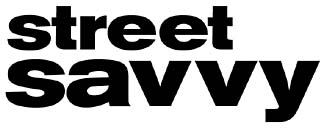
DENNIS ODA / DODA@STARBULLETIN.COM
Dean Song, left, and Rhandy Tambio hit the streets in In4mation's original graphic tees, at $22 each.
Active lifestyles inform
latest looks to hit the streets
Graphic tees with the latest art designs, jeans with seams that break the norm and limited-edition shoes are all part of the rise of individualism in Hawaii's streets, and it's a look that's destined for classrooms this fall.
"It's a lifestyle of just being different and unique," said Gavin Kobayashi, co-owner of Prototype, in Windward Mall.
"Street" is the rising trend that borrows from diverse youth lifestyles, such as the skateboarding, snowboarding and club worlds, to give the average suburban mall rat instant street cred and cool. After all, who wants to look like they're trying? The aim is an air of actively living, not lounging around.
According to owners at Prototype, street appeals to customers ranging in age from 8 to 40.
The graphic tees are popular with young customers because of their affordability, while pricier items such as the jeans or shoes are snatched up by adults wishing to remain as young as they want to be.
To get the street look, customers should hunt for T-shirts with limited-edition graphics ranging from cartoon characters such as Felix the Cat or Snoopy, to abstract art, retro designs or athletic prints such as those on sports jerseys.
"The younger skateboard market is branded by kiddie graphics such as cartoon characters, but the older skateboard market is branded by street influences such as graffiti, music, street artists, urban city life and action sports," said Ryan Arakaki, co-owner of In4mation, in Ward Warehouse.
DENNIS ODA / DODA@STARBULLETIN.COM
Ren Chang, left, stands out against the sunset in a Zoo York top ($24) and Esoteric handmade denim skirt ($160), while Cassie Bratakos wears a Staple T-shirt ($28), also from In4mation.
Jeans with different washes, treatments and seams, along with the graphic tees, help to complete the basic street look. Seams may run down the front or zigzag around.
Engineered JEANS with ergonomic fit also are gaining popularity. These jeans are designed for comfort, featuring seams that follow the body's contours.
Washes and treatments have long been a way for designers to give jeans varying degrees of fade and weights, personalizing this ubiquitous garment.
Limited-edition shoes complete the street look. Graffiti artists and companies such as Heineken -- yes, the beer maker -- work in collaboration with shoe manufactures such as Nike to produce footwear that can't be found at mainstream Niketown or Foot Locker stores, but only via street specialists such as In4mation or Prototype.
Prices range from $19 to $30 for T-shirts, $40 to $80 for jeans and bottoms, $90 to $300 and up for shoes, $19 to $30 for headgear and $4 to $80 for accessories.
In addition to the street clothing, designers are extending their artistic skills to creating limited-edition toys, including figurines dressed in street gear.
Todd Shimabuku, co-owner of In4mation, says the street look is gaining popularity because it gives customers a chance to wear something that represents who they are and what they stand for.
DENNIS ODA / DODA@STARBULLETIN.COM
Behind bars are Ren Chang, left, in an Esoteric camo top ($65), and Cassie Bratakos in a Staple T-shirt ($28), both from the In4mation store at Ward Warehouse.
"I love to rock graphic T-shirts because of their dope designs that help show who I am as an individual," said University of Hawaii senior Khai Tran.
Owners at In4mation believe the street style started with the skateboarding mentality of being different. "A lot of people that were into skateboarding are now fashion designers," Shimabuku said.
The key to staying unique is to find graphic tees with rare designs. Prototype co-owners Kobayashi, Danny Ganiko and Chris Wright create their own designs for their store brand. Only 100 shirts are created for each design because, Arakaki says, "a lot of people like to be exclusive and to have things other people can't have."
After he and his partners saw the urban look in cities such as New York, Arakaki said he wanted to bring in clothing not found in more conservative retail stores. But as the look has taken off, they've all watched the niche street labels become mainstream. "We can see the mainstream companies like Diesel and GAP actually looking toward that type of style."
Arakaki and Kobayashi believe the street trend will not fade, but will evolve.
"Street credibility won't be lost, because the street/urban market will always be changing and the lifestyle market will always be on top of these changes before the mainstream," says Arakaki. "The mainstream usually follows the designs and fashion styles of the lifestyle market, but by then the lifestyle market will be on to another style or fashion trend influenced by street/urban culture."
He says street is divided into two markets: lifestyle and mainstream. The former customers are more likely to keep up with fashion trends, music and overall street lifestyle and will seek clothes to set themselves apart from the mainstream. The other consumers will adopt the looks only after they are reinterpreted for mainstream consumption by stores such as Macy's or Urban Outfitters.
Cindy King, a fashion design major at the University of Hawaii, believes that street, like any other fashion trend, has a temporary shelf life.
"It's eventually going to go mainstream, but it's going to come and go. That's how fashion is: It never stays the same," she said, explaining that skateboarders and their type of lifestyle have always been around but only recently captured the mainstream imagination, making the rise of the street look possible.
"Once the style is overplayed, it's going to go out of style, but the people who lived the street lifestyle before it went mainstream will still wear the clothes," she said.
Click for online
calendars and events.




